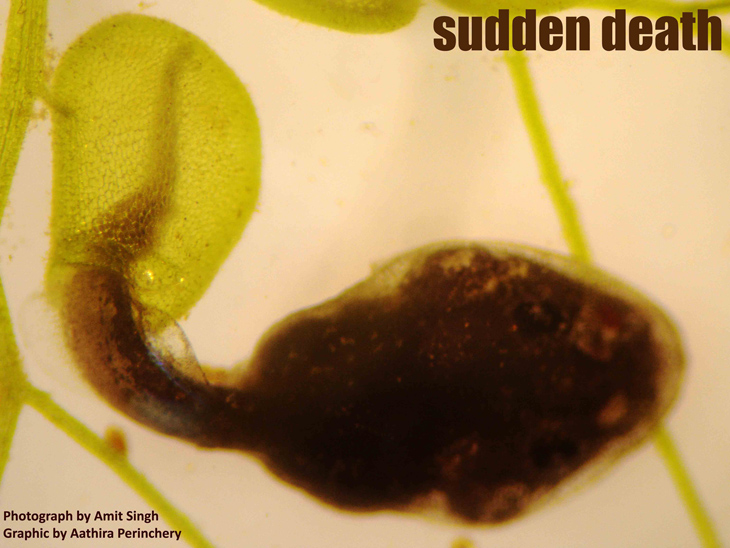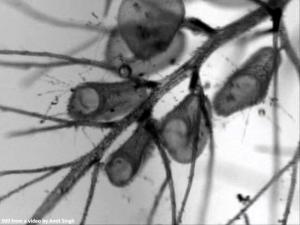Sudden death: In the blink of an eye
The fastest carnivorous plant: a small aquatic species belonging to the bladderwort genus now holds that distinction. Scientists at the National Centre for Biological Sciences (NCBS) filmed Utricularia stellaris trapping its prey and found that it was the fastest ever recorded for a carnivorous plant. The finding reaffirms that even organisms without muscle and nervous systems can evolve mechanisms that make them fast enough to outsmart prey with advanced sensorimotor capacities.
Mechanisms that plants use to 'move' have long fascinated scientists. Movement could be the splitting open of a pea-pod; or the curling of the leaves of the Touch-Me-Not; or the snapping shut of the jaw-like lobes of the Venus flytrap. But carnivorous plants like the flytrap are quite unlike other moving plants: they use movement to capture prey that range from insects and reptiles to even small birds and mammals - species that have bodies with nervous systems designed for rapid escape. Most carnivorous plants have evolved ingenious strategies to catch these prey. Venus flytraps have lobe-shaped leaves that close around the prey as soon as movement-sensitive hairs on the leaf's surface are triggered. Others such as pitcher plants have leaves modified into pitfall traps into which prey are lured.
The group of aquatic carnivorous plants called bladderworts have evolved an even more elaborate structure to catch their prey: leaves shaped into goblet-like bladders that remain submerged in water. Each bladder is only a few millimeters long and is equipped with a trapdoor (see cartoon below). To catch its prey, the plant initially pumps out water from the bladder, thus creating a vacuum - a lowering of pressure inside the bladder. Hairs present on the surface of the bladder's trapdoor trigger it to open when moving prey brush against them. Low pressure within the bladder now creates a suction flow which draws all the water nearby including the prey into the bladder. The trapdoor then closes to digest its food. Using this process, bladderworts suck in prey ranging from small insect larvae to tadpoles, all in the blink of an eye.
To measure just how fast bladderworts capture prey, NCBS scientists Amit Singh, Sunil Prabhakar and Sanjay Sane filmed prey capture by the bladderwort Utricularia stellaris, a species commonly found in lakes and ponds in India. They used a high-speed camera that can record anywhere up to 180,000 frames per second. "This is an interchangeable lens camera and we used a 105 mm macro lens combined with 36 mm extension tubes which further magnifies the image," says Singh. While filming, the authors stimulated the trigger hairs of individuals of U. stellaris and found that the trapdoors opened in about half a millionth of a second (300-700 microseconds). The trapdoor of U. stellaris remained open for 1-3 milliseconds and closed in about 1-2 milliseconds, during which time the bladder had sucked in its prey.
To better understand this mechanism and the role of internal suction in prey capture, the authors needed to first measure pressure within the bladder. Singh and his colleagues custom-designed a 'pressure microprobe' by attaching a 10 micron tip to a small graded capillary filled with water, and introduced an air bubble into the capillary. Changes in the volume of the air bubble correspond to pressure values. They carefully inserted this customized microprobe into the bladder through its walls. They found the pressure within the bladder was considerably lower than that outside: a difference about the same as that created by a medium-powered vacuum cleaner. To cross-check their results, the scientists determined the rate at which water flows into the bladder. They placed neutrally buoyant fluorescent beads at the mouth of the bladder and looked at their movement using high-speed cameras. They measured the flow rate to be 2.7 meters per second, which matched with estimates based on the pressure difference they had measured. This confirmed that pressure had indeed caused the suction after the opening of the trapdoor.
But what causes the lowering of pressure within the bladder? The study has opened up a lot of questions. How do the trigger hairs on the trapdoor respond to prey movement? "The trap opens in 300 microseconds. Is it just mechanical?," asks Singh. Or can there be other mechanisms at work? Stimulation of trigger hairs in the Venus flytrap, for instance, cause electrical signals to create a gradient of water pressure which ultimately causes the trap to close. What "devices" have these plant cells evolved to attain such fast movements? Do the size and geometry of traps play a role in how fast they can capture prey? All these are questions that Singh hopes to answer in future, further elucidating the intricate mechanisms involved in the prey-capture events of carnivorous plants.
Read the entire paper "The biomechanics of fast prey capture in aquatic bladderworts" published in the journal Biology Letters at http://rsbl.royalsocietypublishing.org/content/7/4/547.full.
The study was covered by The Scientist magazine, and you can access the link here http://www.the-scientist.com/?articles.view/articleNo/29582/title/Video-Plant-predators/.
You can also view on YouTube videos of prey capture by U. stellaris that Singh and his colleagues recorded: http://www.youtube.com/watch?v=L7CzAVxkfeo and http://www.youtube.com/watch?v=q-7wCPtaM6o.




Comments
Post new comment